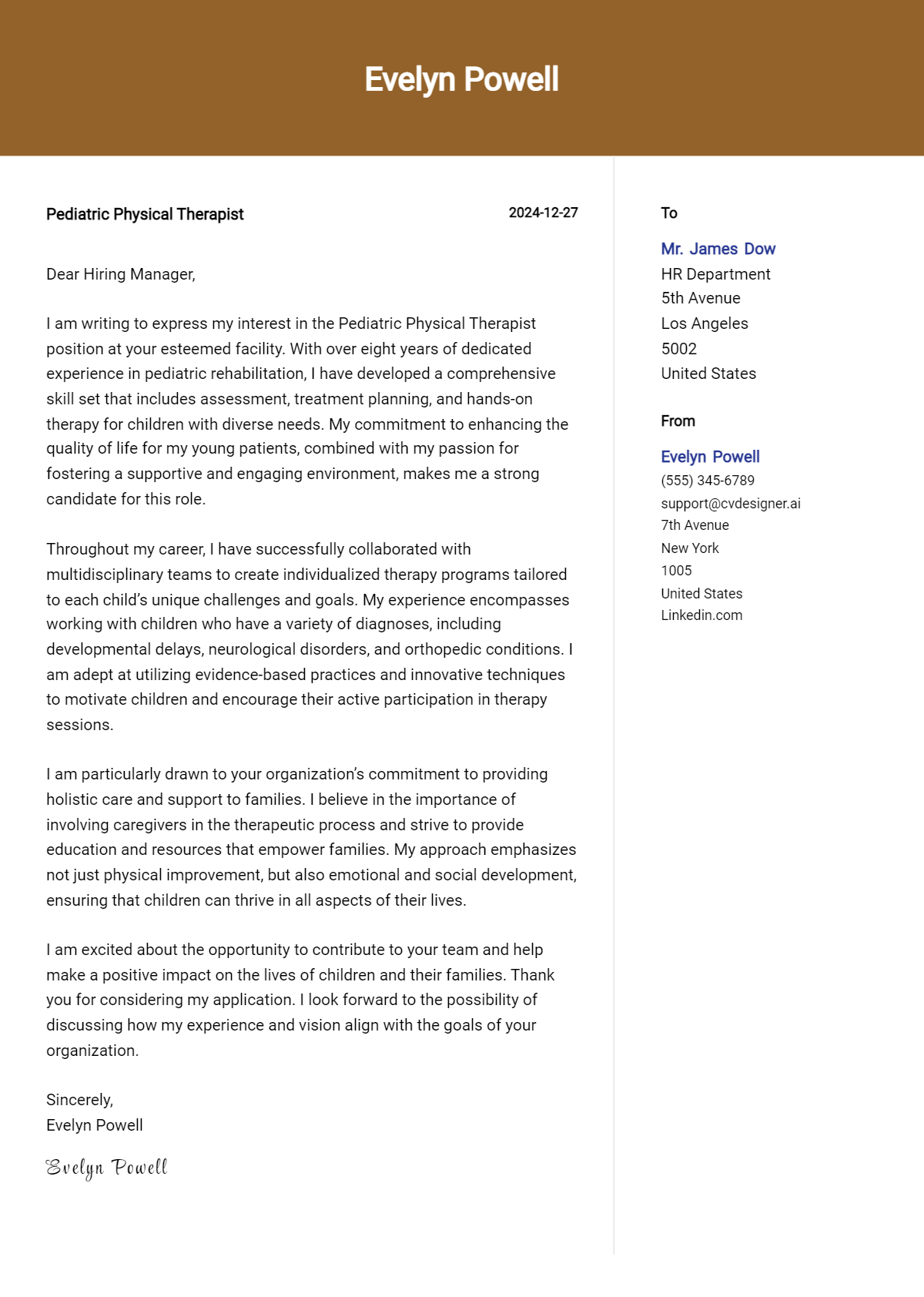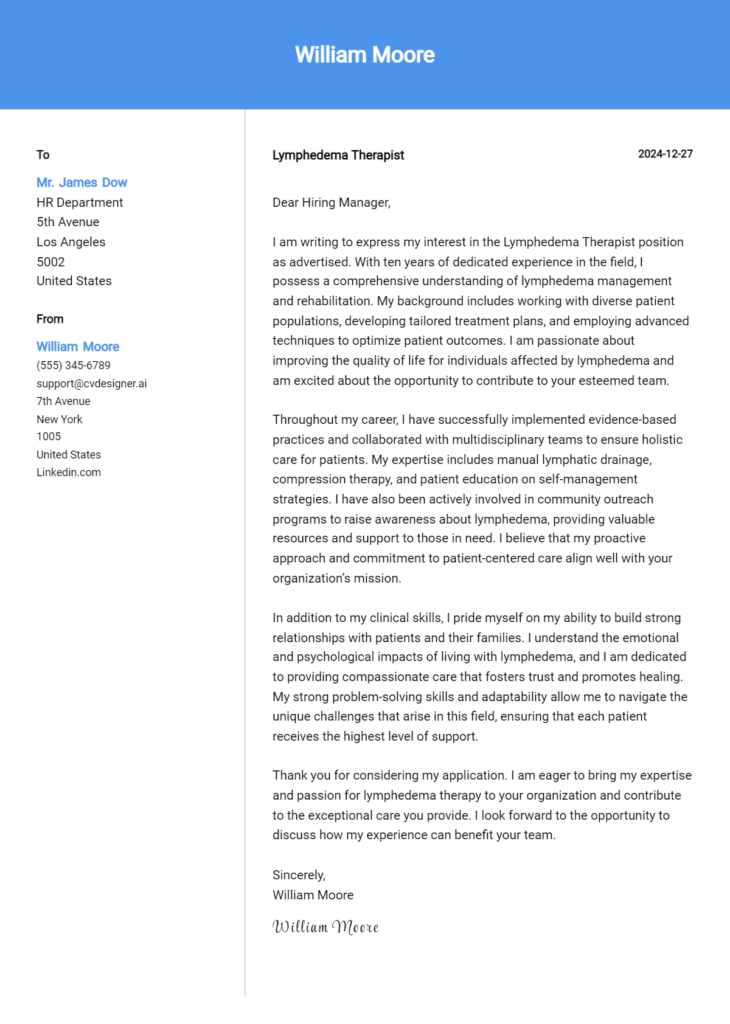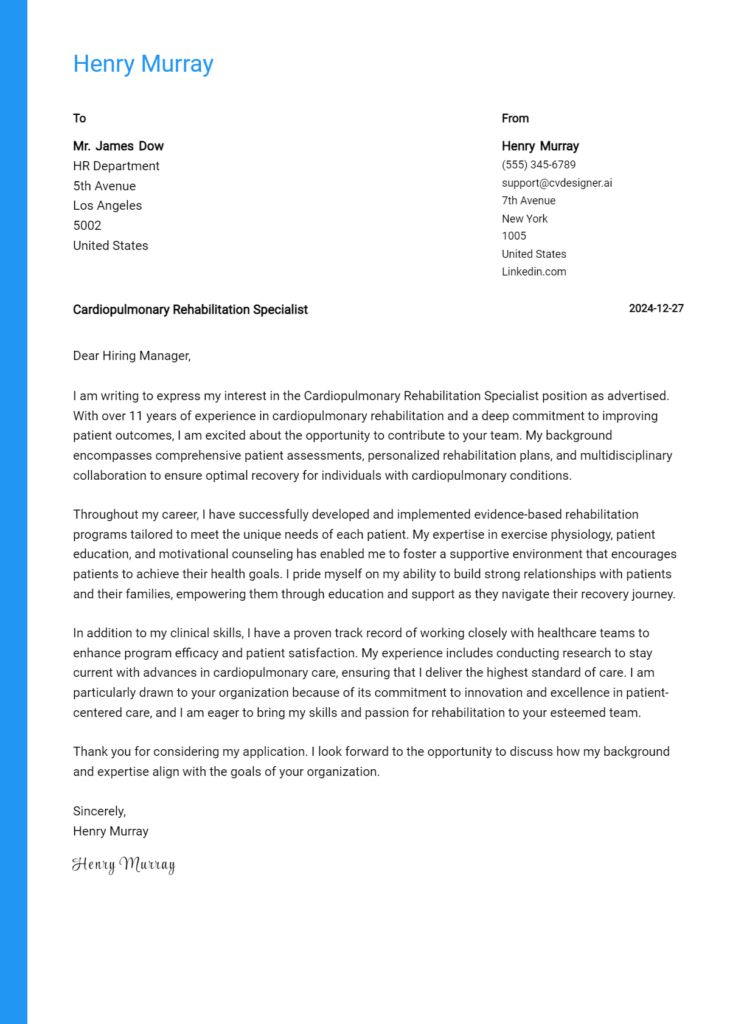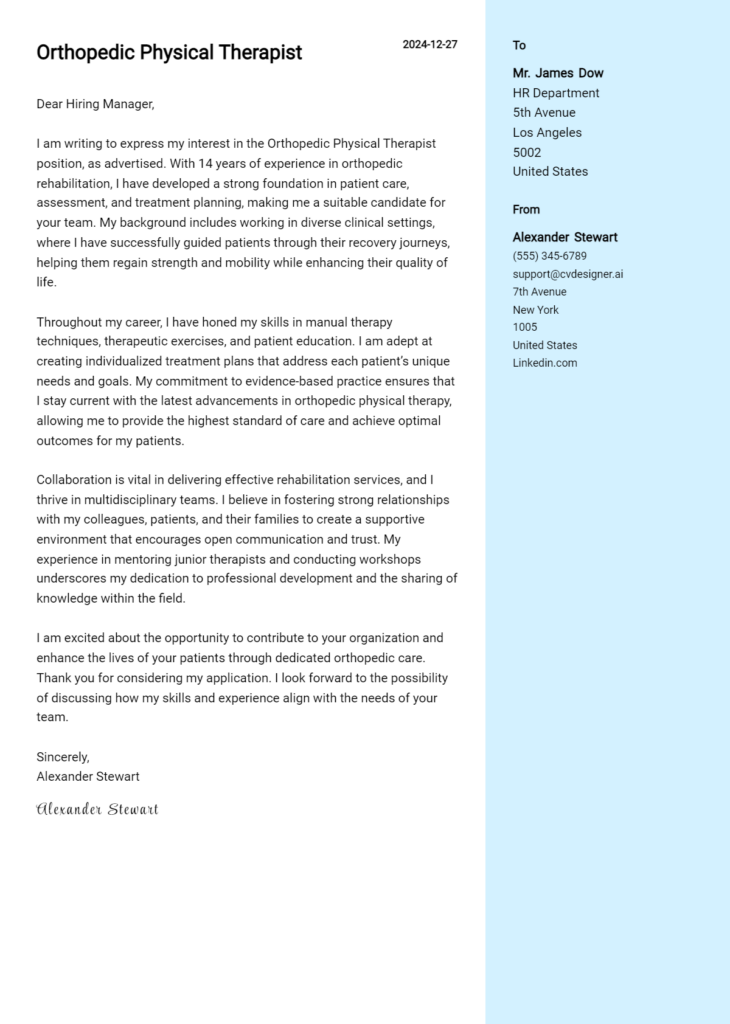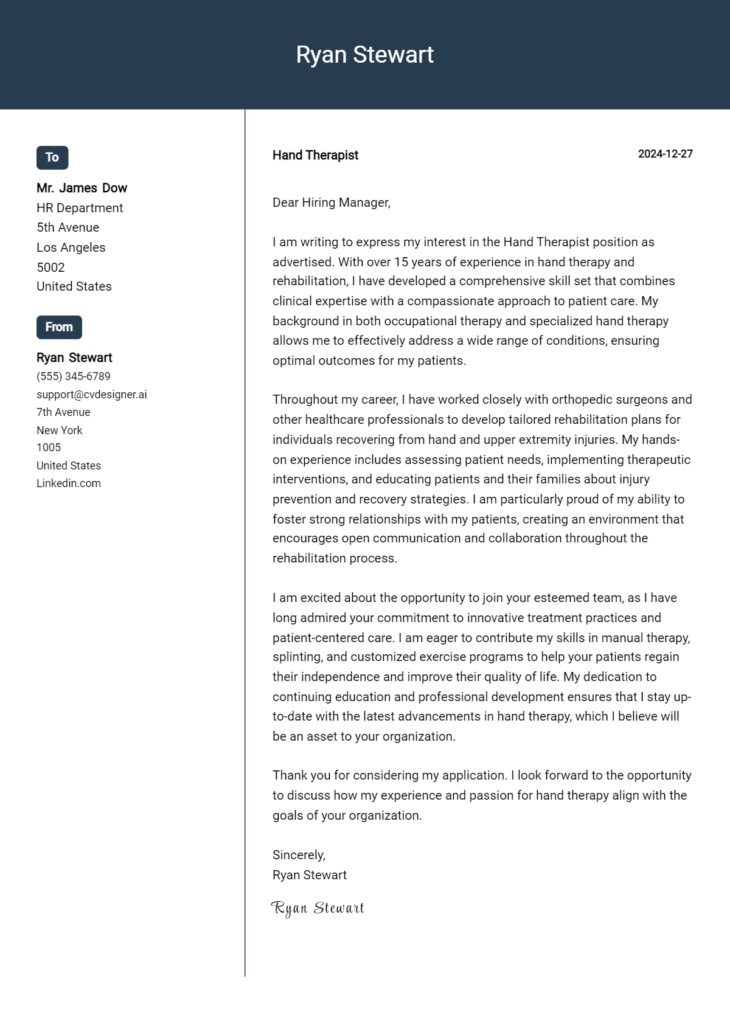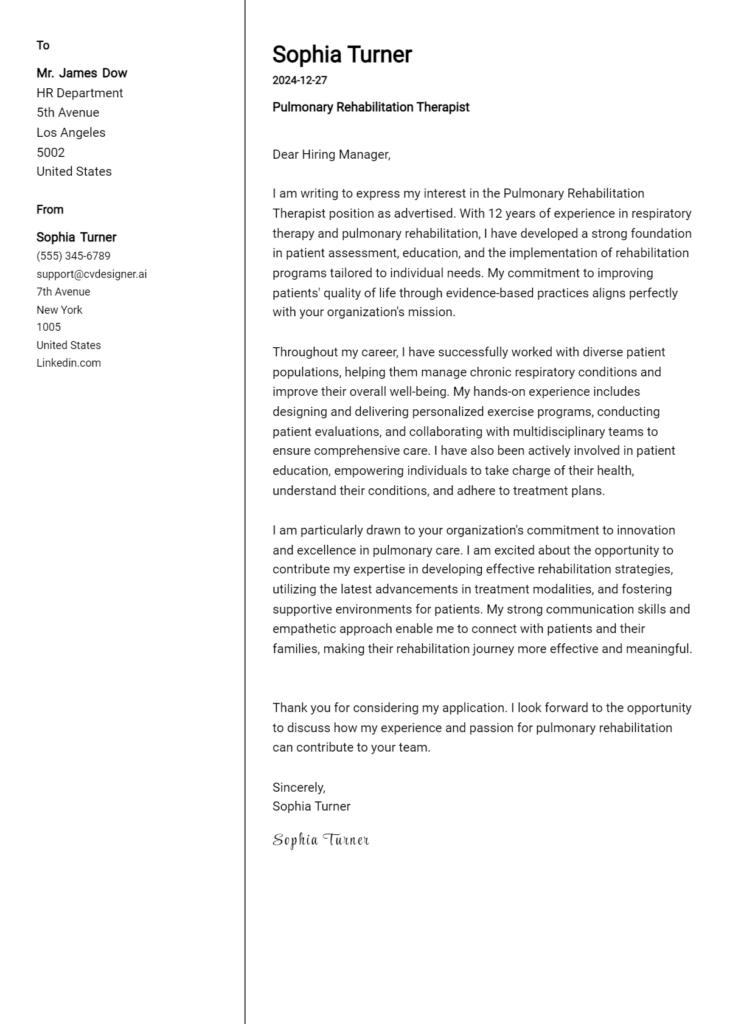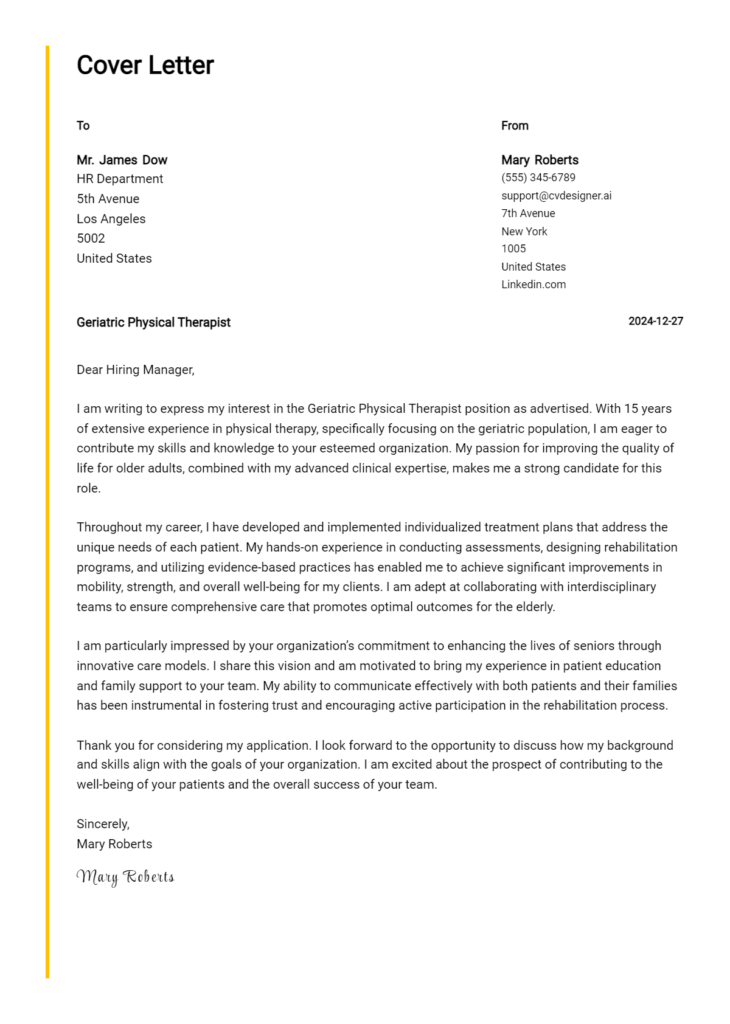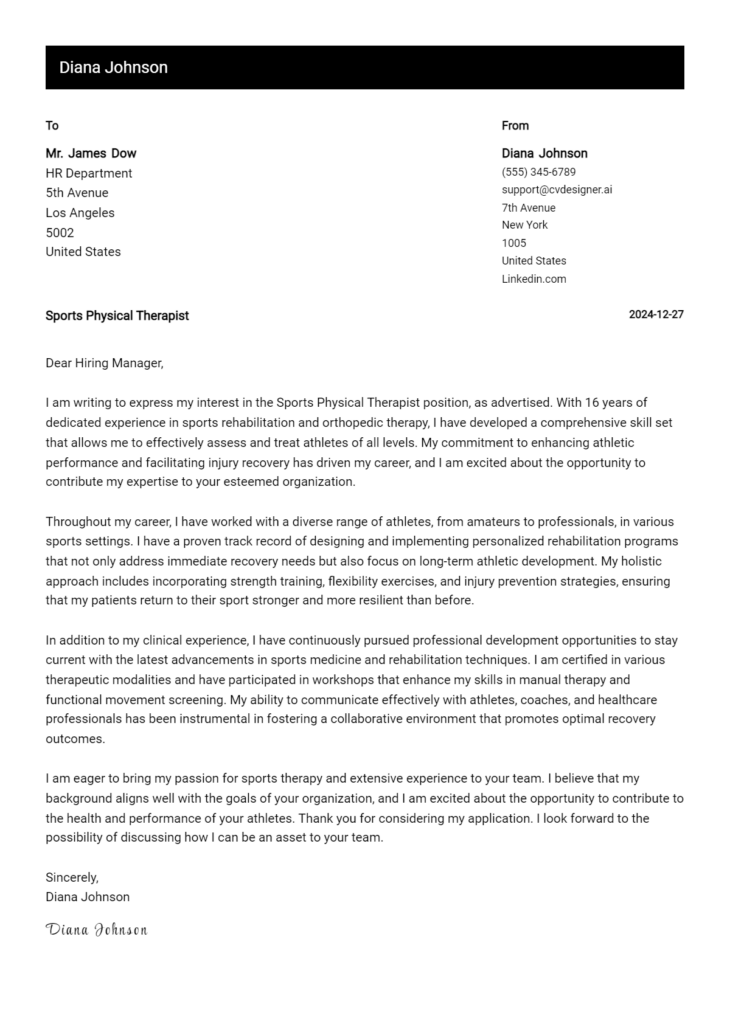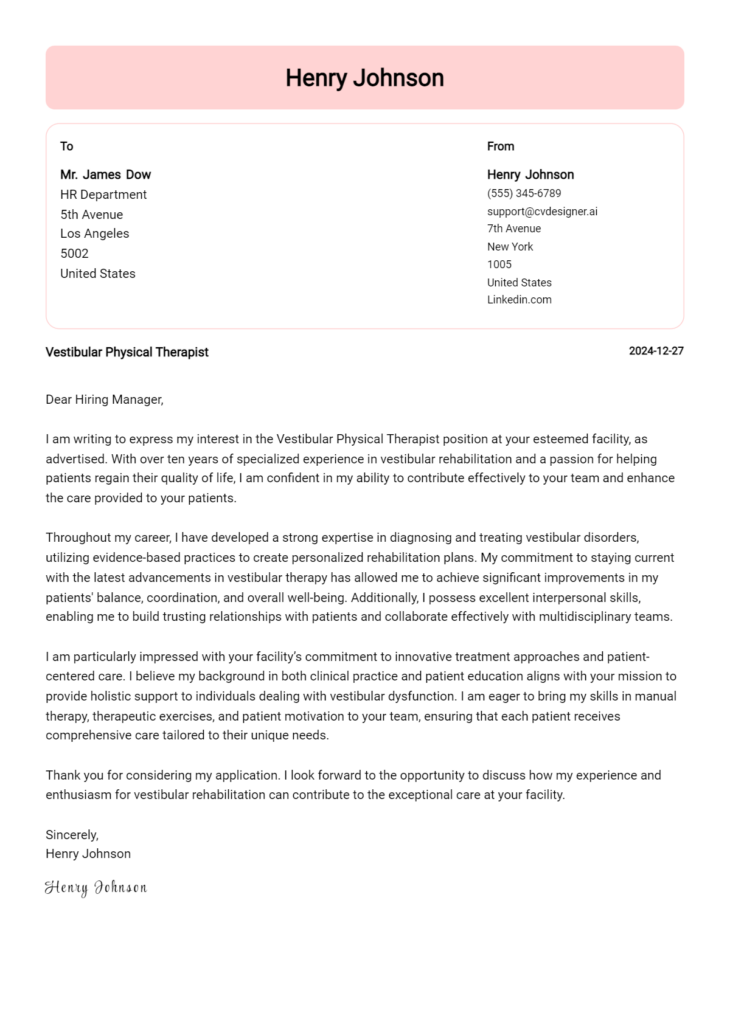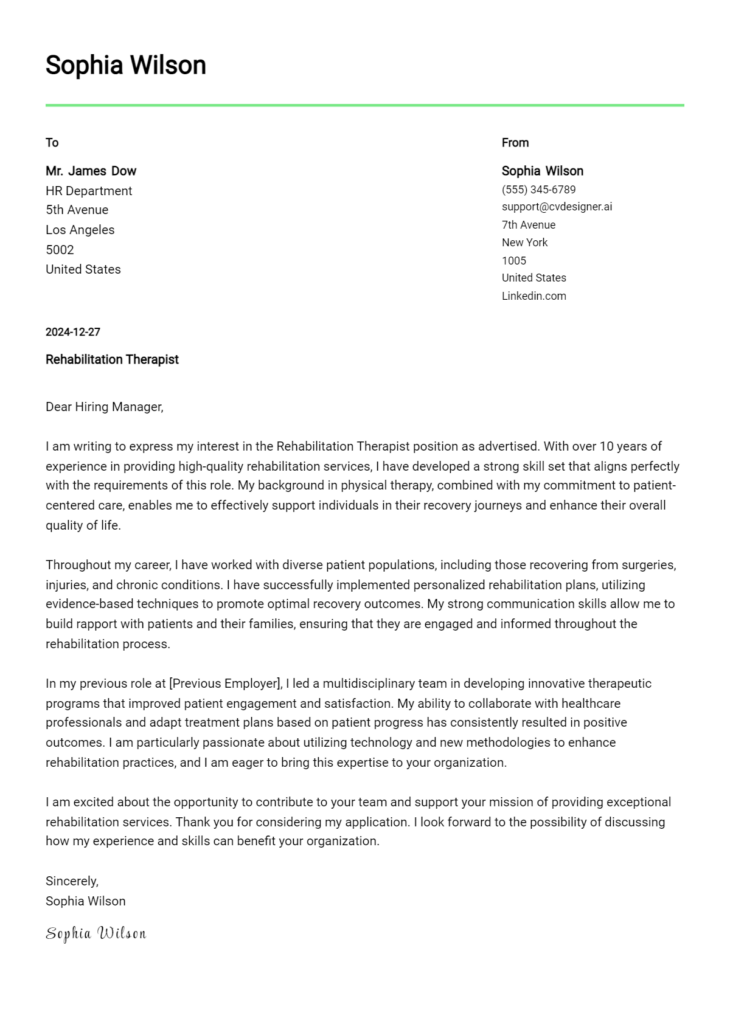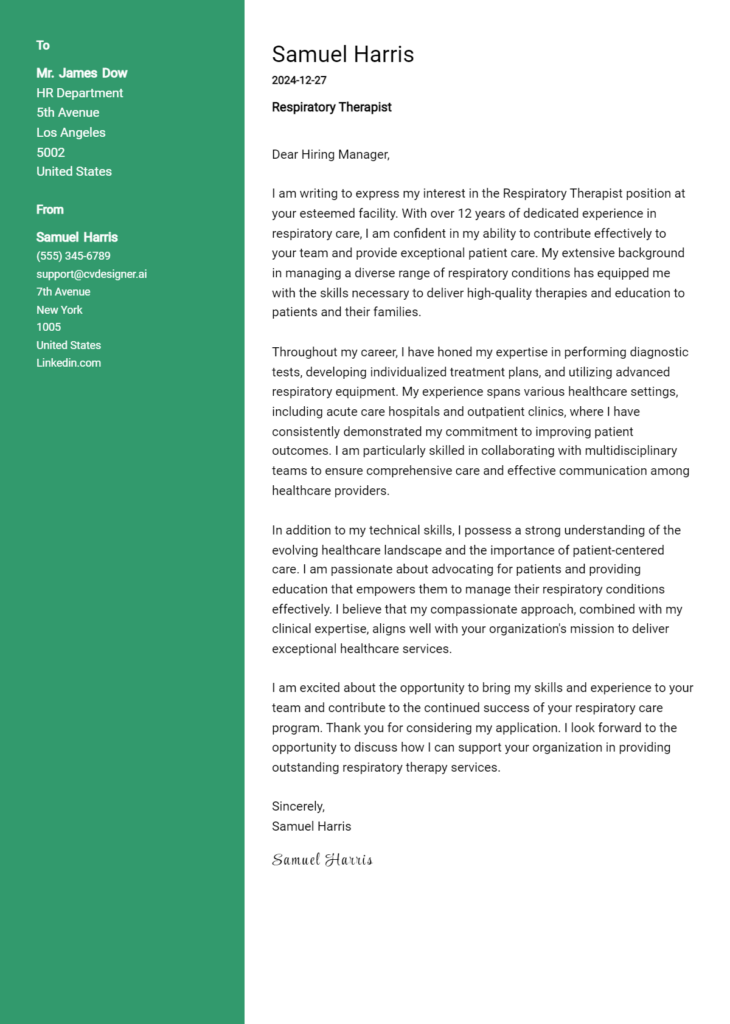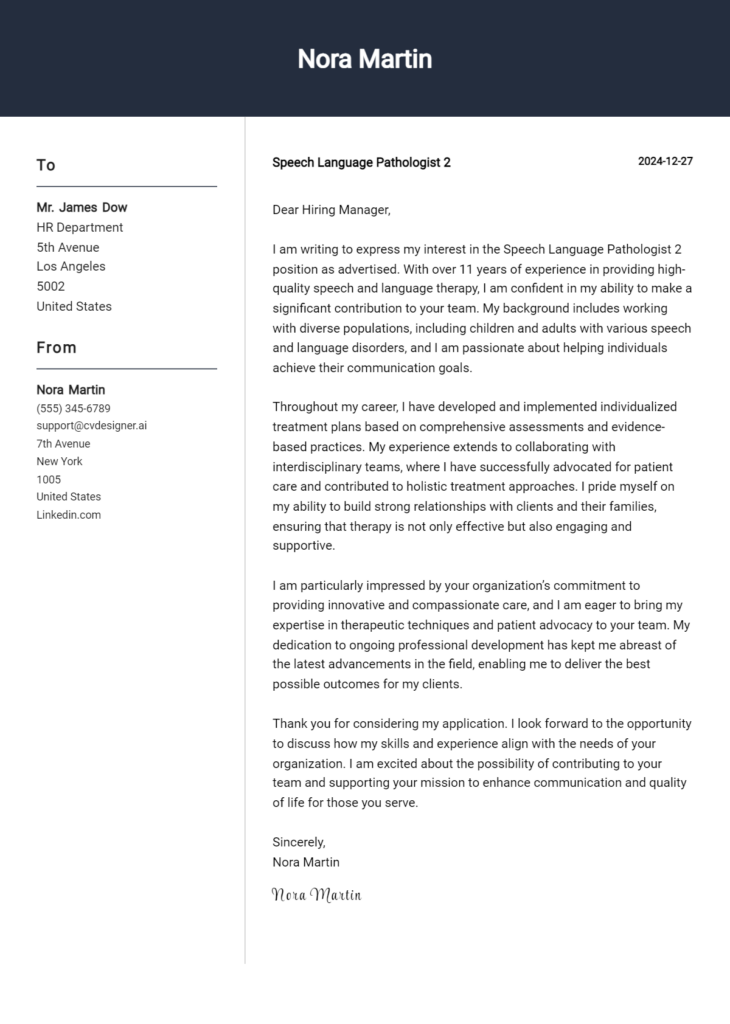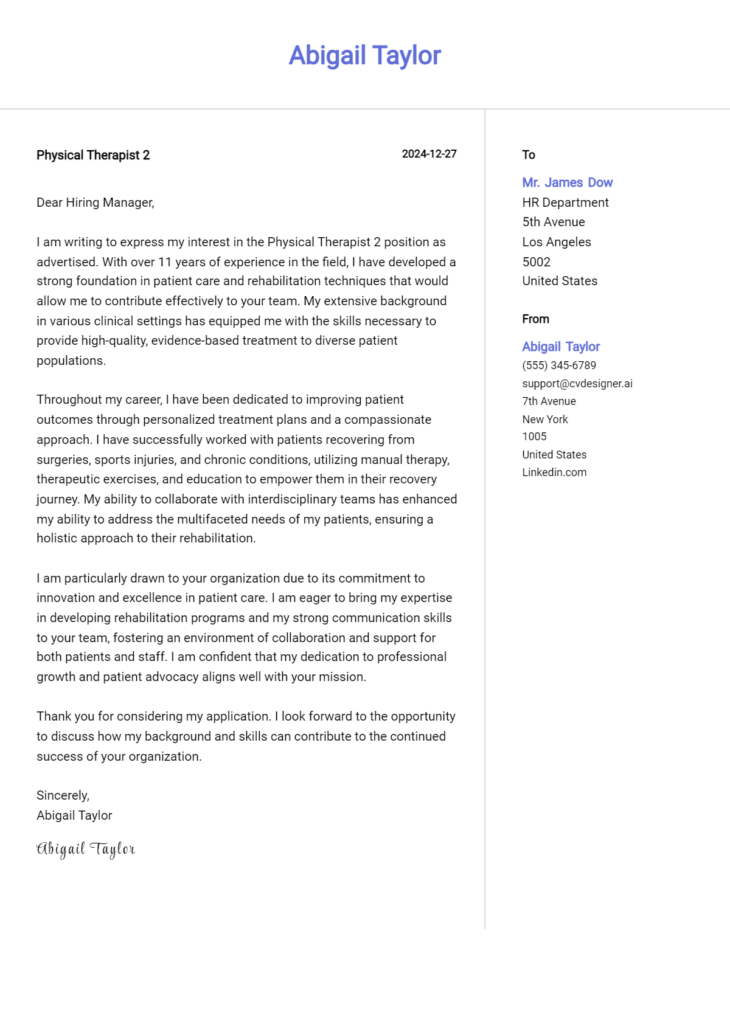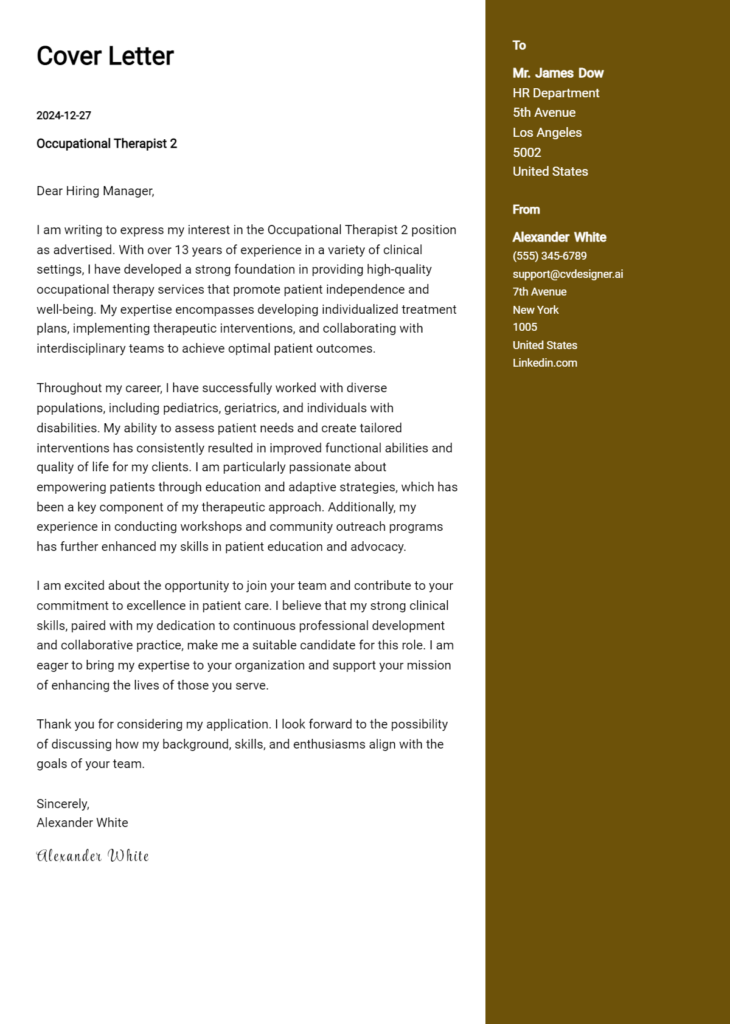Pediatric Physical Therapist Cover Letter Examples
Explore additional Pediatric Physical Therapist cover letter samples and guides and see what works for your level of experience or role.
How to Format a Pediatric Physical Therapist Cover Letter
Crafting an effective cover letter is essential for Pediatric Physical Therapists, as it not only showcases your qualifications but also highlights your ability to connect with families and promote child development. The format of your cover letter plays a pivotal role in making a strong first impression, reflecting your professionalism and dedication to pediatric care. A well-structured cover letter can capture the attention of hiring managers, demonstrating your communication skills—an essential trait in this field.
In this guide, we will outline how to properly structure your cover letter, providing valuable insights and pediatric-specific examples to help you create a compelling document.
We will focus on the essential components of a professional cover letter, including:
- Cover Letter Header
- Cover Letter Greeting
- Cover Letter Introduction
- Cover Letter Body
- Cover Letter Closing
Each section is crucial for effectively highlighting your qualifications and commitment to pediatric physical therapy. Let’s delve into each part and explore how to make your cover letter stand out.
Importance of the Cover Letter Header for a Pediatric Physical Therapist
The cover letter header is a critical component of any job application, including for a Pediatric Physical Therapist. It establishes a professional tone and provides essential information that helps the recipient easily identify the sender and context of the application. A well-structured header should include the applicant's contact information, the date, and the recipient's details, ensuring clarity and professionalism. This is the first impression a potential employer will have, making it crucial to present oneself in an organized manner.
Strong Example
Jane Doe, PT, DPT 123 Caring Lane Happy Town, ST 12345 (123) 456-7890 jane.doe@email.com October 1, 2023 Mr. John Smith Hiring Manager Children's Therapy Center 456 Helping Hand Blvd Support City, ST 67890
Weak Example
Jane Doe Happy Town 10/01/23 John
The Importance of a Strong Greeting in Your Cover Letter
The greeting of your cover letter is crucial as it sets the initial tone for your application. A well-crafted greeting demonstrates professionalism and shows that you have taken the time to personalize your letter by addressing the hiring manager directly. This small yet significant detail can make a lasting impression and encourage the reader to engage with the rest of your application. To avoid generic greetings, it's essential to do some research to find the recipient's name, which adds a personal touch and shows your genuine interest in the position.
Tips for Crafting Your Greeting:
- Avoid generic greetings such as "To Whom It May Concern" or "Dear Hiring Manager."
- Research the company to find the name of the hiring manager or the appropriate contact person.
- If the name is not readily available, consider calling the office to inquire or using a professional title.
Strong Greeting Example
Strong Greeting Example
Dear Ms. Johnson,
Weak Greeting Example
Weak Greeting Example
To Whom It May Concern,
The Importance of a Well-Crafted Cover Letter Introduction for a Pediatric Physical Therapist
A well-crafted cover letter introduction is crucial for a Pediatric Physical Therapist as it sets the tone for the entire application. This paragraph should not only capture the hiring manager's attention but also convey the candidate's genuine interest in the role. A strong introduction provides a snapshot of key skills and achievements, making it easier for the reader to see the candidate's potential fit within the organization. A compelling introduction can make a significant difference in whether a candidate is invited for an interview, while a weak one may lead to their application being overlooked.
Strong Example
Dear [Hiring Manager's Name], I am thrilled to apply for the Pediatric Physical Therapist position at [Company Name], as it aligns perfectly with my passion for enhancing the physical well-being of children. With over five years of experience in pediatric rehabilitation and a proven track record of developing individualized therapy plans that have improved mobility and strength in young patients, I am excited about the opportunity to contribute to your esteemed team. My dedication to fostering a supportive and engaging therapeutic environment has consistently resulted in positive outcomes, and I am eager to bring this commitment to [Company Name].
Weak Example
To whom it may concern, I am writing to express my interest in the Pediatric Physical Therapist position. I have some experience in physical therapy, and I think I could do a decent job. My resume has more details about my background. I hope to hear from you soon.
Purpose of the Cover Letter Body for a Pediatric Physical Therapist
The body of a cover letter for a Pediatric Physical Therapist serves as a critical space to communicate the candidate's relevant skills, experiences, and the unique value they bring to the role and the organization. This section allows the applicant to highlight specific projects or accomplishments that demonstrate their expertise in pediatric care, such as developing individualized therapy plans or successfully collaborating with multidisciplinary teams to enhance patient outcomes. By effectively showcasing these attributes, the candidate can create a compelling narrative that aligns their professional journey with the needs and goals of the prospective employer.
Strong Example
Dear [Hiring Manager's Name], I am excited to apply for the Pediatric Physical Therapist position at [Company Name]. With over five years of experience specializing in pediatric rehabilitation, I have successfully implemented evidence-based interventions tailored to each child's unique needs. For instance, I developed a comprehensive therapy program for children with cerebral palsy, which resulted in a 30% improvement in mobility over six months. My collaborative approach with families and educational teams has fostered supportive environments that encourage progress and confidence in young patients. I am eager to bring my passion for pediatric therapy and proven track record of positive outcomes to your team. Sincerely, [Your Name]
Weak Example
Dear [Hiring Manager's Name], I want to apply for the Pediatric Physical Therapist job at [Company Name]. I have experience working with kids, and I think I would be a good fit. I have done some therapy work and have helped some children. I enjoy working with children and have been involved in some projects. I believe I can help your company, and I am looking forward to the opportunity. Best, [Your Name]
Importance of the Cover Letter Closing for a Pediatric Physical Therapist
The closing paragraph of a cover letter is crucial for leaving a lasting impression on potential employers. It serves as a final opportunity to summarize your qualifications, reiterate your enthusiasm for the position, and encourage the next steps in the hiring process. A strong closing can effectively remind the employer of your relevant skills and experiences while expressing your eagerness to discuss them further in an interview. Conversely, a weak closing may fail to convey your interest or leave the employer unsure of how to proceed.
Strong Example
Thank you for considering my application for the Pediatric Physical Therapist position at [Company Name]. I am excited about the opportunity to contribute my expertise in pediatric rehabilitation and my passion for improving children's quality of life. I believe my hands-on experience and dedication to patient-centered care align well with your team's goals. I look forward to the opportunity to discuss my application further and am eager to provide additional insights during an interview. Please feel free to review my attached resume for more details on my qualifications.
Weak Example
Thanks for reading my letter. I think I would be okay for the Pediatric Physical Therapist job. Please look at my resume. Let me know if you want to talk.
When applying for a Pediatric Physical Therapist position, a well-crafted cover letter can set you apart from other candidates. This document is your opportunity to showcase not only your technical skills and experience but also your problem-solving abilities, knowledge of the software development life cycle (SDLC), teamwork aptitude, and a genuine passion for continuous learning. The following tips will help you create an effective cover letter that highlights these crucial aspects, increasing your chances of landing an interview.
Tips for Writing an Effective Cover Letter for Pediatric Physical Therapist
Highlight Relevant Technical Skills
Emphasize your expertise in pediatric physical therapy techniques, such as developmental assessments, therapeutic exercises, and adaptive equipment usage. Mention any relevant certifications or specialized training that demonstrate your proficiency in working with children and their unique needs. Tailoring your skills to the job description can make a significant impact.Showcase Problem-Solving Abilities
Provide examples of how you've effectively addressed challenges in your previous roles. Whether it's developing a unique therapy plan or adapting techniques to meet a child's specific needs, clearly articulate your thought process and the positive outcomes of your interventions. This will demonstrate your critical thinking and adaptability in a dynamic environment.Demonstrate SDLC Knowledge
While SDLC is often associated with software development, the principles can apply to your approach in therapy as well. Discuss how you assess a child's needs, plan treatment, implement strategies, and evaluate results. This structured methodology showcases your organized approach to therapy and your commitment to achieving measurable outcomes.Emphasize Teamwork and Collaboration
Pediatric physical therapy often requires collaboration with other healthcare professionals, families, and educational staff. Share experiences where you've successfully worked within a multidisciplinary team, highlighting your communication skills and ability to foster a supportive environment for the patient. This shows that you're not only a team player but also value the contributions of others in achieving optimal patient outcomes.Express a Passion for Continuous Learning
The field of pediatric physical therapy is constantly evolving. Mention any ongoing education, workshops, or certifications that you've pursued to stay updated on best practices and new techniques. Your commitment to professional development shows prospective employers that you are dedicated to providing the highest quality care and are eager to grow in your role.
By integrating these tips into your cover letter, you can effectively convey your qualifications and enthusiasm for the Pediatric Physical Therapist position. For additional assistance, consider using our cover letter templates or our cover letter builder to create a polished and professional document.
Common Mistakes to Avoid in a Pediatric Physical Therapist Cover Letter
Crafting a compelling cover letter for a Pediatric Physical Therapist position is essential for standing out in a competitive job market. Avoiding common mistakes can significantly enhance your chances of success. Here are some prevalent pitfalls to steer clear of:
Generic Salutation: Addressing your cover letter with a generic "To Whom It May Concern" can be off-putting. Always try to find the hiring manager's name for a personal touch.
Lack of Specificity: Failing to mention the specific job title or the organization can make your letter feel impersonal. Tailor your letter to the exact role you’re applying for.
Rehashing Your Resume: Your cover letter should complement your resume, not repeat it. Highlight unique experiences or skills that make you a good fit for pediatric physical therapy.
Ignoring the Job Description: Not aligning your skills and experiences with the job description can lead to a disconnect. Analyze the requirements and incorporate relevant examples from your background.
Poor Formatting: A cluttered or unprofessional format can detract from your message. Utilize proper cover letter format to ensure clarity and professionalism.
Neglecting to Proofread: Spelling mistakes or grammatical errors can undermine your credibility. Always proofread your letter or ask someone else to review it before submission.
Being Overly Formal or Casual: Striking the right balance in tone is crucial. Aim for a professional yet approachable style to connect with your reader effectively.
By steering clear of these common mistakes and focusing on a well-structured and personalized cover letter, you can significantly improve your chances of landing that Pediatric Physical Therapist position. For further inspiration, check out some cover letter examples.
Cover Letter FAQs for Pediatric Physical Therapist
What should I include in my cover letter as a Pediatric Physical Therapist?
In your cover letter, be sure to include your relevant qualifications, experience, and passion for pediatric care. Start with a strong opening that captures the reader's attention, mentioning the specific position you're applying for. Highlight your educational background, such as your degree in physical therapy and any specialized training in pediatrics. Discuss your hands-on experience working with children, including specific techniques or modalities you use. Additionally, emphasize your soft skills, like communication and empathy, which are crucial when working with young patients and their families. Conclude with a compelling statement about your commitment to improving children's mobility and quality of life, and express your enthusiasm for the potential opportunity.
How can I demonstrate my passion for pediatric physical therapy in my cover letter?
To effectively convey your passion for pediatric physical therapy, share personal anecdotes or experiences that inspired you to pursue this specialty. Discuss specific instances where you made a positive impact in a child’s rehabilitation journey, such as celebrating a patient’s milestones or collaborating with families to achieve goals. Mention any volunteer work, internships, or continuing education courses related to pediatric care that showcase your dedication. Additionally, express your understanding of the unique challenges and joys of working with children, and how you stay motivated in this rewarding field. This heartfelt narrative will resonate with hiring managers and illustrate your genuine commitment to improving the lives of children through therapy.
How should I address my cover letter?
Addressing your cover letter correctly is crucial for making a positive impression. Start by researching the hiring manager's name, which can often be found on the company's website or LinkedIn. If you find it, use a formal greeting such as "Dear [Manager's Name]." If the name isn't available, you can use a general greeting like "Dear Hiring Manager" or "To Whom It May Concern." Avoid using overly casual greetings, as professionalism is key in healthcare settings. Additionally, ensure that you follow the standard format, including your contact information at the top, the date, and the employer's details, to create a polished and professional presentation.
How can I tailor my cover letter for a specific Pediatric Physical Therapist position?
Tailoring your cover letter involves aligning your skills and experiences with the specific requirements of the job listing. Start by carefully reviewing the job description to identify key competencies and responsibilities highlighted by the employer. Customize your opening paragraph to reflect your understanding of the organization’s mission and how your values align with theirs. In the body of your letter, draw direct connections between your experience and the job's requirements, emphasizing relevant achievements or case studies from your past work. Use specific keywords from the job posting to demonstrate that you are a perfect fit for the role. This personalized approach shows your genuine interest in the position and helps you stand out to potential employers.
Build your Cover Letter in minutes
Use an AI-powered cover letter builder and have your letter done in 5 minutes. Just select your template and our software will guide you through the process.

